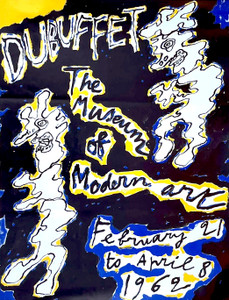
Jean Dubuffet, Coucou Bazar at the Grand Palais, Paris, 1973 original poster by Jean Dubuffet, 1973
Jean DubuffetJean Dubuffet
Coucou Bazar at the Grand Palais, Paris, 1973 original poster by Jean Dubuffet, 1973
Offset typeset lithograph and lithograph
Bears publishers' stamp on the back, unsigned
Unnumbered
27 × 20 1/2 inches
Unframed
In 1973, Jean Dubuffet, a pioneer of the Art Brut movement, created this iconic poster to promote his interactive and innovative performance art piece, Coucou Bazar, at the Grand Palais in Paris. This event was part of the Festival d'Automne, an annual arts festival established celebrating avant-garde and contemporary works across multiple artistic disciplines. [Called an ‘animated painting’, it was later performed in New York during Dubuffet's retrospective at the Solomon R. Guggenheim Museum.] His Coucou Bazar was a bold, interdisciplinary performance, merging painting, sculpture, and movement. It brought his two-dimensional works to life through animated performances of his characters and abstract forms, immersing the audience in a lively, ever-evolving experience of art in motion. The event took place from September 28 to December 20, 1973, at the Grand Palais, with a special Coucou Bazar performance on November 28 and 29. Printed by SMI in Paris, this poster is now a collectible piece, symbolizing Dubuffet’s contribution to the evolution of modern and performance art. It serves as a visual reminder of the dynamic intersection of art forms that Coucou Bazar embodied and the spirit of artistic experimentation that characterized Dubuffet’s career. Exhibition Grand Palace - The Autumn Festival in Paris Global Printing Society.
This work is unframed and unsigned, bearing the publisher’s stamp.
In recent years, the internationally renowned PACE Gallery retrospectively celebrated Dubuffet’s groundbreaking performance, which they described as follows:
With Coucou Bazar, Dubuffet set out to bring his multifarious abstractions to life through what he described as a “spectacle.” Eschewing theatrical conventions in favor of the expansive possibilities of painting, the artist was intensely interested in upending viewers’ expectations and disrupting their modes of perception in the process. The large-scale performance, which encompasses 20 characters in elaborate costumes made of various materials, dissonant music and sounds, and “praticables”—mobile paintings bearing dizzying forms—exemplifies the artist’s ability to blur the boundary between art and life. He imbued his works with illusionistic, shapeshifting elements, dispatching viewers and, in the case of Coucou Bazar, performers to other worlds.
“The aim is to make the spectator consider all the elements in the ensemble capable of movement and not just those which are in fact mobile,” Dubuffet wrote of Coucou Bazar in a 1972 memo. “All must be endowed with a semblance of life, or at least an intensification of their powers to evoke a world of uncertain and unstable figures, which are perpetually shifting in and out of transitory combinations and transformations.”
As Elodie Bergerault, choreographer of Fragments: Coucou Bazar, explains in the film documenting the making of the performance, the costumes for the work have a totalizing effect on their occupants. “You have to feel,” she says of the importance of embodying Dubuffet’s characters in Coucou Bazar. “This is the spirit of your performance: to feel the costume, and then to tell you a story. You have to find a story for you.” Heavy and multifaceted, the costumes dictate performers’ speed and range of movements. Dubuffet wrote in the 1972 missive that “those who wear the costumes should move only slightly and very slowly. At times they should even remain completely motionless.” As Astor put it, “No movement is extraneous. Everything is very deliberate—a conversation with the audience.” The artist’s explorations of objecthood are also on full view in the Coucou Bazar costumes, regardless of whether they are experienced from without or within. “Being inside the costume definitely feels like you’re in a different universe,” Hedderwick Turner said of donning her costume with the help of a team. “You kind of get transformed or taken into that universe as the costume is assembled.”
The transportive qualities of Coucou Bazar are evident in much of Dubuffet’s work, including pieces from his storied Hourloupe cycle spanning 1962 to 1974. Many of the large-scale architectural and sculptural interventions in that series, including Closerie Falbala in Périgny-sur-Yerres, France and the Groupe de quatre arbres in New York, are among Dubuffet’s most famous artworks today. Like Pace’s Fragments: Coucou Bazar performance on the streets of London, experiential works from this prolific period of Dubuffet’s career—representing the longest lasting cycle of his practice—beckon viewers into realms beyond their immediate environments.
-Courtesy PACE Gallery
Originally a wine merchant, Dubuffet vehemently defied artistic traditions by creating stark, primitive pieces inspired by the artwork of children and the insane, who he believed were uncontaminated by culture. Indifferent to concepts of beauty and ugliness, his subjects were portrayed as dehumanized individuals lost amidst the chaos of cramped spaces. In many of his works, he incorporated a thick impasto of asphalt, pebbles and glass. Although Dubuffet's artwork and all its post-war angst was often reviled, it strongly impacted the emergence of Pop Art and neo-Dadaism.







